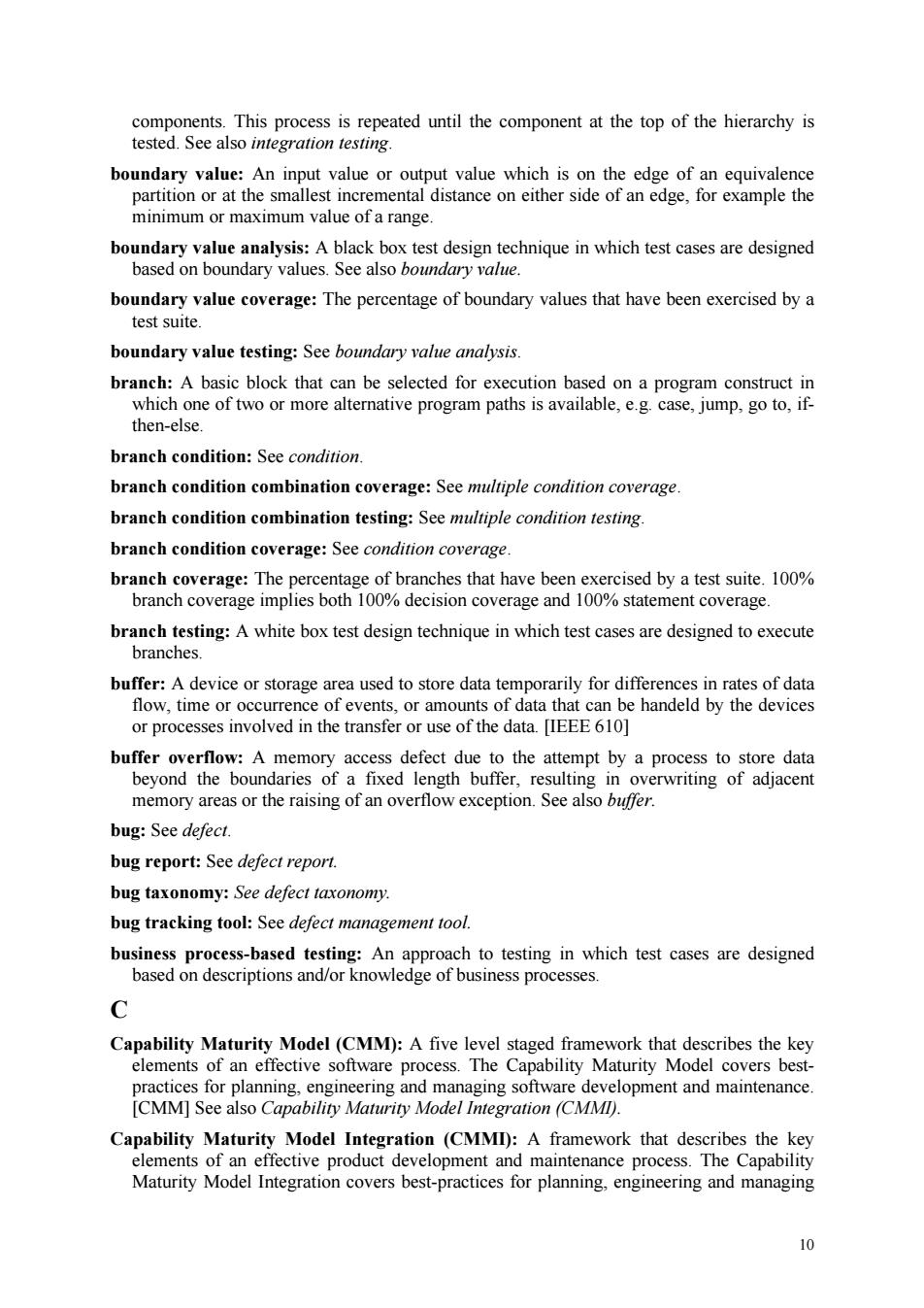正在加载图片...

components.This process is repeated until the component at the top of the hierarchy is tested.See also integration testing. :An input value or oupu value which isn the edge menta distance on either side of an edge,for example the boundary value analysis:A black box test design technique in which test cases are designed based on boundary values.See also bo mndary value boundary value coverage:The percentage of boundary values that have been exercised by a test suite. boundary value testing:See boundary value analysis terative program pa on a progran then-elof le,e.g.case,Jump,go to, branch condition:See condition branch condition combination coverage:See multiple condition coverage branch condition combination testing:See multiple condition testing. branch condition coverage:See condition coverage branch coverage:The percentage of branches that have been exercised by a test suite.100% branch coverage implies both 100%decision coverage and 100%statement coverage. branch testing:A white box test design technique in which test cases are designed to execute branches. of data odevice or stora area used to store data temporaly for dtedevices or processe buffer overfow:A memory access defect duc to the attempt by a process to store data beyond the boundaries of a fixed length buffer,resultir g in ove memory areas or the raising of an overflow exception.See also buffer. bug:See defect. bug report:See defect report. bug taxonomy:See defect taxonomy. bug tracking tool:See defect management tool. business process-based testing:An approach to testing in which test cases are designed based on descriptions and/or knowledge of business processes Capability Maturity Model(CMM):A five level staged framework that describes the key elements of an effective software process.The Capability Maturity Model covers best- practices for planning,engineering and managing software development and maintenance. [CMM]See also Capability Maturity Model Integration (CMMI). Capability Maturity Model Integratio (CMMI):A framework that describes the e product elopment an maintenance process.The Capability Maturity Model ntegration covers best-practices for panggan manag 1010 components. This process is repeated until the component at the top of the hierarchy is tested. See also integration testing. boundary value: An input value or output value which is on the edge of an equivalence partition or at the smallest incremental distance on either side of an edge, for example the minimum or maximum value of a range. boundary value analysis: A black box test design technique in which test cases are designed based on boundary values. See also boundary value. boundary value coverage: The percentage of boundary values that have been exercised by a test suite. boundary value testing: See boundary value analysis. branch: A basic block that can be selected for execution based on a program construct in which one of two or more alternative program paths is available, e.g. case, jump, go to, ifthen-else. branch condition: See condition. branch condition combination coverage: See multiple condition coverage. branch condition combination testing: See multiple condition testing. branch condition coverage: See condition coverage. branch coverage: The percentage of branches that have been exercised by a test suite. 100% branch coverage implies both 100% decision coverage and 100% statement coverage. branch testing: A white box test design technique in which test cases are designed to execute branches. buffer: A device or storage area used to store data temporarily for differences in rates of data flow, time or occurrence of events, or amounts of data that can be handeld by the devices or processes involved in the transfer or use of the data. [IEEE 610] buffer overflow: A memory access defect due to the attempt by a process to store data beyond the boundaries of a fixed length buffer, resulting in overwriting of adjacent memory areas or the raising of an overflow exception. See also buffer. bug: See defect. bug report: See defect report. bug taxonomy: See defect taxonomy. bug tracking tool: See defect management tool. business process-based testing: An approach to testing in which test cases are designed based on descriptions and/or knowledge of business processes. C Capability Maturity Model (CMM): A five level staged framework that describes the key elements of an effective software process. The Capability Maturity Model covers bestpractices for planning, engineering and managing software development and maintenance. [CMM] See also Capability Maturity Model Integration (CMMI). Capability Maturity Model Integration (CMMI): A framework that describes the key elements of an effective product development and maintenance process. The Capability Maturity Model Integration covers best-practices for planning, engineering and managing